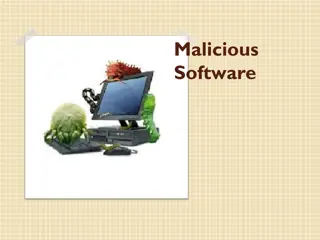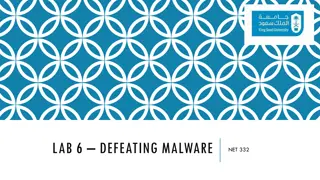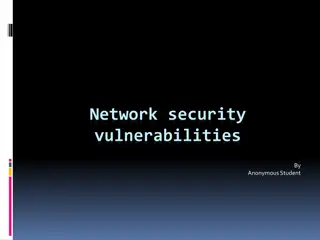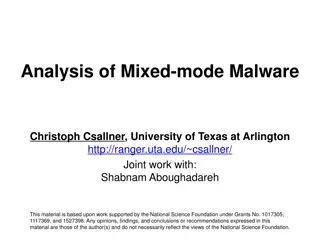Strategies Against Malware Attacks
Learn effective defenses against malware including preventing exploits, utilizing non-executable memory, combating return-oriented programming, implementing ASLR, and more to enhance your system's security against cyber threats.
Download Presentation

Please find below an Image/Link to download the presentation.
The content on the website is provided AS IS for your information and personal use only. It may not be sold, licensed, or shared on other websites without obtaining consent from the author.If you encounter any issues during the download, it is possible that the publisher has removed the file from their server.
You are allowed to download the files provided on this website for personal or commercial use, subject to the condition that they are used lawfully. All files are the property of their respective owners.
The content on the website is provided AS IS for your information and personal use only. It may not be sold, licensed, or shared on other websites without obtaining consent from the author.
E N D
Presentation Transcript
Preventing exploits Fix bugs: Audit software Automated tools: Coverity, Prefast/Prefix. Rewrite software in a type safe languange (Java, ML) Difficult for existing (legacy) code Concede overflow, but prevent code execution Add runtime code to detect overflows exploits Halt process when overflow exploit detected StackGuard, LibSafe,
Non-executable memory Prevent attack code execution by marking stack and heap as non-executable NX-bit on AMD Athlon 64, XD-bit on Intel P4 Prescott NX bit in every Page Table Entry (PTE) Deployment: Linux (via PaX project); OpenBSD Windows: since XP SP2 (DEP) Visual Studio: /NXCompat[:NO] Limitations: Some apps need executable heap (e.g. JITs). Does not defend against `Return Oriented Programming exploits
Example: DEP In windows:
Return oriented programming Control hijacking without executing code Idea: overwrite the return address rather than try to execute code in stack or heap Can reroute to /bin/sh, for example, instead of continuing in the current execution library Much harder to defend against But does require that the attacker know where to return to!
Response: randomize! ASLR: (Address Space Layout Randomization) Map shared libraries to rand location in process memory Attacker cannot jump directly to exec function Deployment: (/DynamicBase in visual studio) Windows Vista: 8 bits of randomness for DLLs: aligned to 64K page in a 16MB region Windows 8: 24 bits of randomness on 64-bit processors Other randomization methods: Sys-call randomization: randomize sys-call id s Instruction Set Randomization (ISR) 256 choices
ASLR Example Booting twice loads libraries into different locations: Note: everything in process memory must be randomized stack, heap, shared libs, image Win 8 Force ASLR: ensures all loaded modules use ASLR
Another attack: JIT spraying Force JavaScript JIT to fill heap with executable shellcode Then point SFP anywhere in spray area NOP slide shellcode execute enabled execute enabled heap execute enabled execute enabled vtable
Run time defenses Many run-time checking techniques we only discuss methods relevant to overflow protection Solution 1: StackGuard Run time tests for stack integrity. Embed canaries in stack frames and verify their integrity prior to function return.
Canary types Random canary: Random string chosen at program startup. Insert canary string into every stack frame. Verify canary before returning from function. Exit program if canary changed. Turns potential exploit into DoS. To corrupt, attacker must learn current random string. Terminator canary: Canary = {0, newline, linefeed, EOF} String functions will not copy beyond terminator. Attacker cannot use string functions to corrupt stack
More on Stackguard StackGuard implemented as a GCC patch Program must be recompiled Minimal performance effects: 8% for Apache Note: Canaries do not provide full protection Some stack smashing attacks leave canaries unchanged Heap protection: PointGuard Protects function pointers and setjmp buffers by encrypting them: e.g. XOR with random cookie Less effective, more noticeable performance effects
StackGuard enhancements: ProPolice ProPolice (IBM) - gcc 3.4.1. (-fstack-protector) Rearrange stack layout to prevent ptr overflow. args ret addr String Growth Protects pointer args and local pointers from a buffer overflow SFP CANARY local string buffers Stack Growth pointers, but no arrays local non-buffer variables copy of pointer args
MS Visual Studio /GS [since 2003] Compiler /GS option: Combination of ProPolice and Random canary. If cookie mismatch, default behavior is to call _exit(3) Function prolog: sub esp, 8 // allocate 8 bytes for cookie mov eax, DWORD PTR ___security_cookie xor eax, esp // xor cookie with current esp mov DWORD PTR [esp+8], eax // save in stack Function epilog: mov ecx, DWORD PTR [esp+8] xor ecx, esp call @__security_check_cookie@4 add esp, 8 Enhanced /GS in Visual Studio 2010: /GS protection added to all functions, unless can be proven unnecessary
/GS stack frame args String Growth ret addr SFP Canary protects ret-addr and exception handler frame exception handlers CANARY local string buffers Stack Growth pointers, but no arrays local non-buffer variables copy of pointer args
Evading /GS with exception handlers When exception is thrown, dispatcher walks up exception list until handler is found (else use default handler) After overflow: handler points to attacker s code exception triggered control hijack Main point: exception is triggered before canary is checked 0xffffffff SEH frame SEH frame high mem ptr to next handler buf next next handler attack code next handler
Defenses: /SAFESEH: linker flag Linker produces a binary with a table of safe exception handlers System will not jump to exception handler not on list /SEHOP: platform defense (since win vista SP1) Observation: SEH attacks typically corrupt the next entry in SEH list. SEHOP: add a dummy record at top of SEH list When exception occurs, dispatcher walks up list and verifies dummy record is there. If not, terminates process.
Summary: canaries are not everything Canaries are an important defense tool, but do not prevent all control hijacking attacks: Heap-based attacks still possible Integer overflow attacks still possible /GS by itself does not prevent Exception Handling attacks (also need SAFESEH and SEHOP)
What if cant recompile: Libsafe Solution 2: Libsafe (Avaya Labs) Dynamically loaded library (no need to recompile app.) Intercepts calls to strcpy (dest, src) Validates sufficient space in current stack frame: |frame-pointer dest| > strlen(src) If so, does strcpy. Otherwise, terminates application
How robust is Libsafe? high memory low src buf sfp ret-addr sfp ret-addr dest memory main Libsafe strcpy strcpy() can overwrite a pointer between buf and sfp.
More methods StackShield At function prologue, copy return address RET and SFP to safe location (beginning of data segment) Upon return, check that RET and SFP is equal to copy. Implemented as assembler file processor (GCC) Control Flow Integrity (CFI) A combination of static and dynamic checking Statically determine program control flow Dynamically enforce control flow integrity
Dealing with legacy code Often, no choice but to deal with unsafe, legacy code Honeypots Programs from the internet (extensions, plugins, etc.) Exposed applications Most common approach is isolation Or sandboxing
Approach: confinement Confinement: ensure misbehaving app cannot harm rest of system Can be implemented at many levels: Hardware: run application on isolated hw (air gap) app 1 app 2 difficult to manage air gap network 1 Network 2
Approach: confinement Confinement: ensure misbehaving app cannot harm rest of system Can be implemented at many levels: Virtual machines: isolate OS s on a single machine app1 app2 OS1 OS2 Virtual Machine Monitor (VMM)
Approach: confinement Confinement: ensure misbehaving app cannot harm rest of system Can be implemented at many levels: Process: System Call Interposition Isolate a process in a single operating system process 1 process 2 Operating System
Approach: confinement Confinement: ensure misbehaving app cannot harm rest of system Can be implemented at many levels: Threads: Software Fault Isolation (SFI) Isolating threads sharing same address space Application: e.g. browser-based confinement
Implementing confinement Key component: reference monitor Mediates requests from applications Implements protection policy Enforces isolation and confinement Must always be invoked: Every application request must be mediated Tamperproof: Reference monitor cannot be killed or if killed, then monitored process is killed too Small enough to be analyzed and validated
A old example: chroot Often used for guest accounts on ftp sites To use do: (must be root) chroot /tmp/guest root dir / is now /tmp/guest su guest EUID set to guest Now /tmp/guest is added to file system accesses for applications in jail open( /tmp/guest/etc/passwd , r ) application cannot access files outside of jail open( /etc/passwd , r )
Jailkit Problem: all utility progs (ls, ps, vi) must live inside jail jailkit project: auto builds files, libs, and dirs needed in jail env jk_init: creates jail environment jk_check: checks jail env for security problems checks for any modified programs, checks for world writable directories, etc. jk_lsh: restricted shell to be used inside jail note: simple chroot jail does not limit network access
Escaping from jails Early escapes: relative paths open( ../../etc/passwd , r ) open( /tmp/guest/../../etc/passwd , r ) chroot should only be executable by root. otherwise jailed app can do: create dummy file /aaa/etc/passwd run chroot /aaa run su root to become root (bug in Ultrix 4.0)
Many ways to escape jail as root Create device that lets you access raw disk Send signals to non chrooted process Reboot system Bind to privileged ports
Freebsd jail Stronger mechanism than simple chroot To run: jail jail-path hostname IP-addr cmd calls hardened chroot (no ../../ escape) can only bind to sockets with specified IP address and authorized ports can only communicate with processes inside jail root is limited, e.g. cannot load kernel modules
Not all programs can run in a jail Programs that can run in jail: audio player web server Programs that cannot: web browser mail client
Problems with chroot and jail Coarse policies: All or nothing access to parts of file system Inappropriate for apps like a web browser Needs read access to files outside jail (e.g. for sending attachments in Gmail) Does not prevent malicious apps from: Accessing network and messing with other machines Trying to crash host OS
System call interposition Observation: to damage host system (e.g. persistent changes) app must make system calls: To delete/overwrite files: unlink, open, write To do network attacks: socket, bind, connect, send Idea: monitor app s system calls and block unauthorized calls Implementation options: Completely kernel space (e.g. GSWTK) Completely user space (e.g. program shepherding) Hybrid (e.g. Systrace)
Initial implementation (Janus) [GWTB 96] Linux ptrace: process tracing process calls: ptrace ( , pid_t pid , ) and wakes up when pid makes sys call. user space monitored application (browser) monitor open( /etc/passwd , r ) Monitor kills application if request is disallowed OS Kernel
Complications cd( /tmp ) open( passwd , r ) If app forks, monitor must also fork forked monitor monitors forked app cd( /etc ) open( passwd , r ) If monitor crashes, app must be killed Monitor must maintain all OS state associated with app current-working-dir (CWD), UID, EUID, GID When app does cd path monitor must update its CWD otherwise: relative path requests interpreted incorrectly
Problems with ptrace Ptrace is not well suited for this application: Trace all system calls or none inefficient: no need to trace close system call Monitor cannot abort sys-call without killing app Security problems: race conditions Example: symlink: me mydata.dat proc 1: open( me ) monitor checks and authorizes proc 2: me /etc/passwd OS executes open( me ) time not atomic Classic TOCTOU bug: time-of-check / time-of-use
Alternate design: systrace [P02] user space monitored application (browser) policy file for app monitor open( etc/passwd , r ) sys-call gateway systrace permit/deny OS Kernel systrace only forwards monitored sys-calls to monitor (efficiency) systrace resolves sym-links and replaces sys-call path arguments by full path to target When app calls execve, monitor loads new policy file
Ostia: a delegation architecture [GPR 04] Previous designs use filtering: Filter examines sys-calls and decides whether to block Difficulty with syncing state between app and monitor (CWD, UID, ..) Incorrect syncing results in security vulnerabilities (e.g. disallowed file opened) A delegation architecture: user space monitored application agent policy file for app open( etc/passwd , r ) OS Kernel
Ostia: a delegation architecture [GPR04] Monitored app disallowed from making monitored sys calls Minimal kernel change ( but app can call close() itself ) Sys-call delegated to an agent that decides if call is allowed Can be done without changing app (requires an emulation layer in monitored process) Incorrect state syncing will not result in policy violation What should agent do when app calls execve? Process can make the call directly. Agent loads new policy file.
Policy Sample policy file: path allow /tmp/* path deny /etc/passwd network deny all Manually specifying policy for an app can be difficult: Systrace can auto-generate policy by learning how app behaves on good inputs If policy does not cover a specific sys-call, ask user but user has no way to decide Difficulty with choosing policy for specific apps (e.g. browser) is the main reason this approach is not widely used
NaCl: a modern day example Browser game NPAPI HTML JavaScript NaCl runtime game: untrusted x86 code Two sandboxes: outer sandbox: restricts capabilities using system call interposition Inner sandbox: uses x86 memory segmentation to isolate application memory among apps























